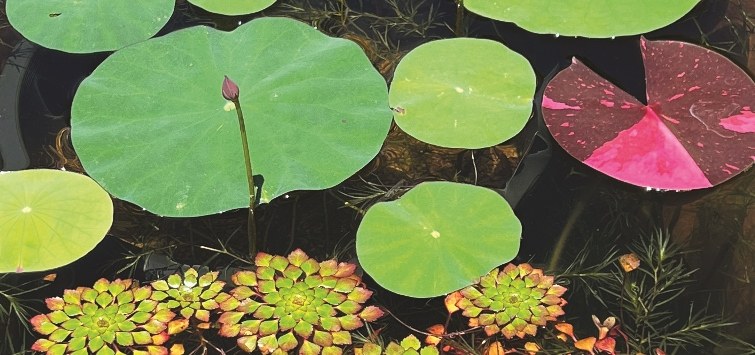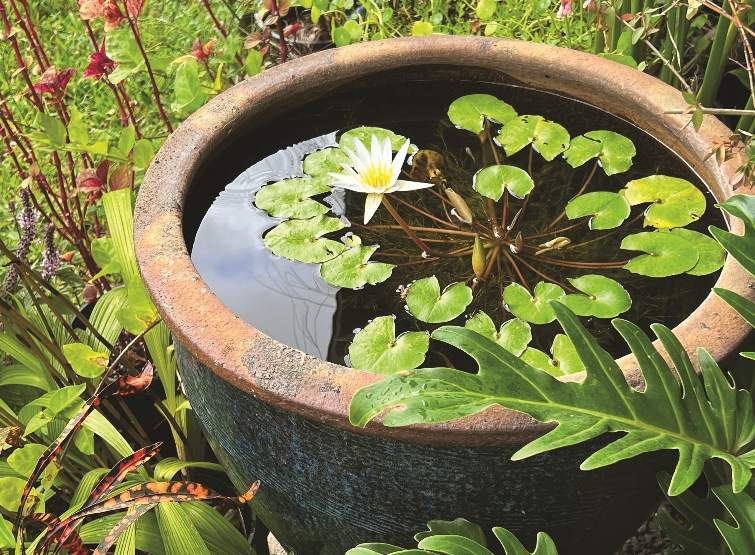Container Ponds for the Summertime Aquascaper
Author: Steve Waldron
Here in the deep northern latitudes of the Pacific Northwest, I find aquariums to be essential for managing my emotional state during the long, cold, dark months of winter. There is something about this hobby, especially the planted aquarium with its vibrant green photosynthetic energy, electric LED grow lights, and swirling shoals of colorful, peaceful tropical fish that has a way of turning my bad-weather frown upside-down.
I’m such a devoted practitioner and believer in the power of aquarium therapy that I have transformed my aquascaping hobby into a successful business over the last 10 years, owning and operating my own little planted aquarium oasis, Aquarium Zen, a specialty aquascaping shop and studio in Seattle.
Aquarium therapy has been a lifeline for me, on several levels, many times throughout my life. However, when nature has woken up from her long winter nap, I find myself wondering about what life could be like lived outdoors, in the sunshine, with birdsongs in the air and vibrant greenery blooming everywhere.
My winter enthusiasm for aquarium upkeep starts to wane a bit in spring, however and I find myself spending more time taking nature walks, birdwatching, and gardening whenever possible. I have noticed a similar trend with my customer base and know that the busy aquarium season usually begins to fade as the days lengthen and summer grows near. And even though summer offers myriad distractions for outdoor play, I try not to let my aquascaping practice fade too much, as it’s such an essential ingredient to my happiness.
And so, I’ve discovered a solution to the summer aquarium doldrums: container ponds! Over the years, I have come to appreciate the art of container ponds as a summer substitute for my indoor aquascaping obsession, allowing me to keep my hands wet 365 days a year.
Container ponds are simple vessels that are kept outdoors and filled with wild vegetative tangles of hardy pond and marginal plants. They offer a naturalistic habitat for fish that can handle the rigors of an environment prone to conditions of low oxygen and rapidly fluctuating temperatures, like goldfish, guppies, medaka (Japanese ricefish), paradisefish, and white cloud mountain minnows. And as a bonus, these outdoor-dwelling fish offer a biological solution to mosquito control.
Most likely, a few millennia ago in China, the very first aquarist was a container pond enthusiast who raised and selected the first ornamental fish strains that looked better cavorting under the sun in beautiful clay pots than they did on the dinner plate.
Though simple in concept—a pot, water, plants, sunlight, fish—container ponds do have their own specific requirements and set of challenges. First, let’s talk about your blank canvas, the pot.
Selecting and Preparing the Container
While almost any water-holding nontoxic container will serve as a container pond, I prefer to use decorative glazed terracotta garden pots that hold at least 5 gallons (19 liters), and preferably more. Unless you’re lucky enough to have sourced a specialized water lily or goldfish pot designed to hold water, your pot will most likely have a drainage hole that needs to be plugged.I’ve been successful with using a two-part epoxy product called J-B Weld that’s available in the plumbing section of most large home improvement stores. Similar two-part epoxies are available, too.
The epoxy is something like a stick of clay, with a darker-colored core. You break off a hunk and just roll it into a ball until it’s uniform. The ball should be big enough for you to be able to seal the hole of your pot, smush it in, and smooth it down around the edges of the hole. Then you let it sit overnight. A water test is essential to ensure your container pond isn’t too leaky; minor cracks and imperfections in your clay pot will be revealed and the epoxy can be applied to seal it up further, if needed.
Once you have a watertight container, you’ll need to decide where you’ll be placing your container pond. Just like with planted aquariums, light duration and intensity are determining factors in what sort of plants you can choose. To allow for a greater diversity of plants, such as water lilies or many pond marginals, you’ll want your container pond to receive around 10 hours of direct sunlight during the growing season.
Choosing the Plants

Again, there are many shade-tolerant varieties of plants, including water lilies, that can be grown with less sunlight. For example, one of my favorite tropical water lily varieties, “Dauben,” is a consistent bloomer in shady locations during the summer.
Now that you have situated your container in a sunny outdoor location, let’s turn to the plants. In general, there are three functional classes of plants that I reach for when thinking up container pond ideas: clarifying plants, floating plants, and feature plants.
Clarifying plants are often plant species familiar to aquarists. I have used Rotala, Ludwigia, hornwort, guppy grass, Elodea, Myriophyllum, Vallisneria, and others for these selections. They are all vigorous and have a fast growth rate, and they act as a natural filter by sequestering pollutants and excess nutrients, in addition to oxygenating the container pond environment.
For the stem-type clarifying plants (Rotala, Ludwigia, Bacopa, etc.), I prefer to root the initial planting in a small, dark plastic pot filled a third of the way with ordinary garden soil and capped with pea gravel or a clay-based gravel. A single pellet of a slow-release fertilizer designed for water plants will keep your plants fed. As the clarifying stem plants breach the surface, you’ll be treated to a wild display of flowers rarely seen under aquarium conditions.
Water hyacinth, water lettuce, Salvinia, Azolla, and other floating plants add a wonderful surface dimension to the container pond and, like the clarifying plants, sequester dissolved waste. In addition, floating plants provide a canopy that shields the lower reaches from excess sunlight and helps keep dreaded algae blooms at bay.
I’ve found the best trick for keeping algae away is to create a canopy of various emergent aquatic plant leaves that cover around 60 to 70 percent of the container pond surface. This shades the water column from excess sunlight but still allows enough energy to penetrate and power the growing plant stems below.
The final piece of the container-pond puzzle is the feature plant. These can be any type that catches the eye of the beholder: Think big, think bold, think bright. I have used papyrus, taro, canna lily, sacred lotus, and more.
For many beginner water gardeners, the jewel in the crown of their first project is a water lily. Some of my favorite varieties of these for full summer sun conditions include “Madame Ganna Walska,” “Star of Siam,” and “Mangkala Ubol.” Water lilies decorate the container pond with delightful lily pads and, of course, their enchanting, colorful, and sweet-smelling blooms. Once you’ve bloomed your first water lily and have had your nostrils filled with its intoxicating scent, you’ll never want to do without one.
A Journey of Discovery

That’s what happened to me. During the late stages of the pandemic, I found myself daydreaming a little too often about faraway shores and tropical oases. At the time, my aquarium business in Seattle was very stable. It had a dedicated staff and a supportive returning customer base. After nearly a decade in business, I felt it was time for a little break from the daily grind of small business stressors, so I sailed away to the island of Maui for an open-ended sabbatical.
I landed on a beautiful tropical fruit farm kissed by the trade winds on the North Shore of the island near the hamlet of Haiku, right off the Hana Highway and within walking distance of the epic Peahi, or “Jaws” surf break.
At that point, I had been dabbling with container ponds for about five years, but the short Seattle summers kept me from fully expressing myself. Just as I thought I was making strides with my designs and creations, the cold hand of the northern winter would come down like a hammer and snuff out my container pond ideas for the next six months. In Hawaii, I had the potential of container pondering year-round and could work with many tropical and subtropical species that might be challenging to grow elsewhere.
The Magnificent Mosaic Plant
One of the goals of my Hawaii container pond sabbatical was to learn how to grow the mosaic plant (Ludwigia sedioides). I admired this iconic species during vacation trips to the island of Kauai, where I learned everything about island-style container pond culture at a whimsical water plant nursery business called Garden Ponds. The staff members there have been my inspiration and guide into the world of water gardening in the semi-tropics, and I encourage a visit if you ever find yourself blessed with an idle afternoon on the Garden Isle.
I was amazed to see, among the vast collection at Garden Ponds, mosaic plants growing in many, if not most, of the designs. One of the cool aspects of this type of aquascaping is that the main view is top-down, and, in essence, you are creating a composition on the surface of your vessel, much like a mosaic composed of floating aquatic plant leaves.
I can’t think of many more inspiring top-down views for the aquatic plant lover than the spiraling whorls of mosaic plant decorating the surface of a container pond. There is something about the perfect geometric beauty of an animal or plant species that flows in a shape harmonized with the Fibonacci sequence that triggers some deep lizard-brain satisfaction, similar to sunflowers, snail shells, and pinecones.
The mosaic plant is one of those species, and I was pretty much willing to risk it all just to have the satisfaction of successfully growing it to Golden Ratio perfection. Fortunately, the mosaic plant is relatively easy to work with, as it only requires slightly acid substrate conditions, warm water—nighttime drops in temperature should not get below 60°F (16°C)—and full sun.
As with most of my container pond plants, I tended to keep my mosaic plants at a depth of 6 to 12 inches (15 to 30 cm) below the surface. From there, under the Hawaiian sun, the plant would send up stems on a consistent basis, with the floating spiral-form fronds blooming with tiny yellow flowers.
Magical Inspiration
Watching my guppies, platies, and medaka cavort under the exotic leaves, perfumes, and blooms of my container pond creations, I felt my skin being kissed by the sun and trade winds, and I realized that this aquascaping journey my life had drifted into is something truly rarified and magical. I wish the same for you in realizing your aquascaping daydreams! And, hey, if you’re finding this column interesting, informational, and inspirational, I’d love to receive an e-mail from you at aquariumzen@gmail.com.

.png?h=595&iar=0&w=2781&hash=5FD5E69473BCC22199FBFA2FB71B6033)



